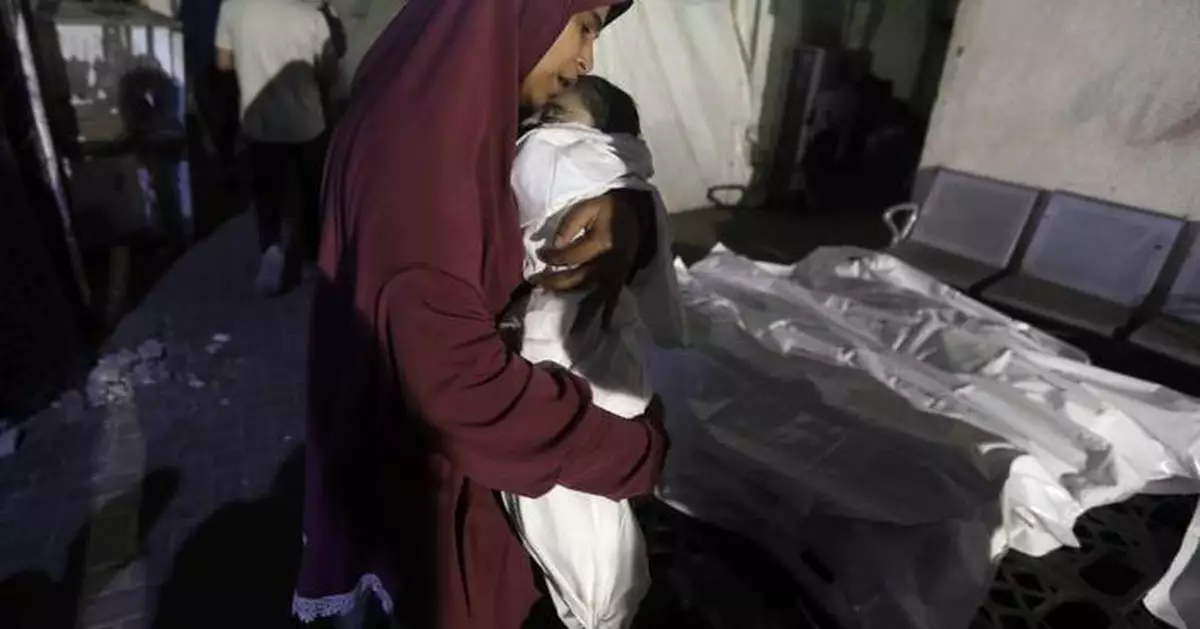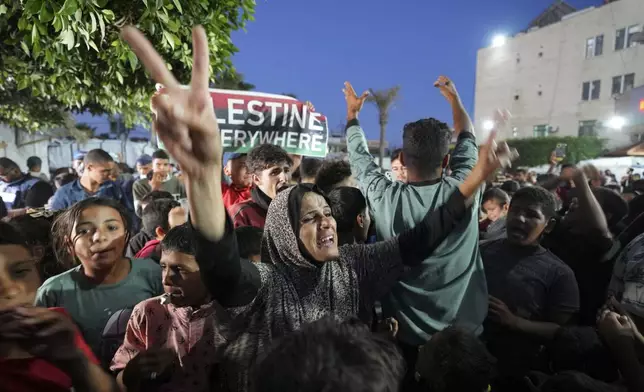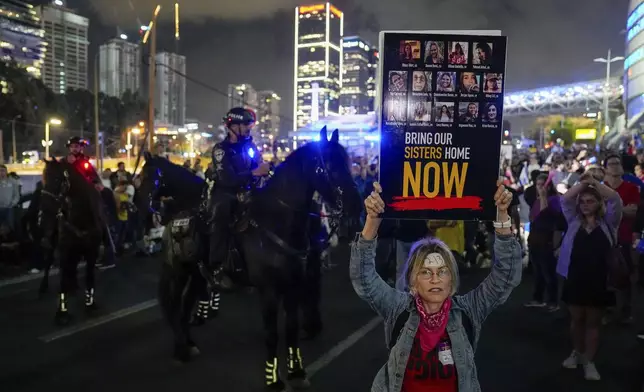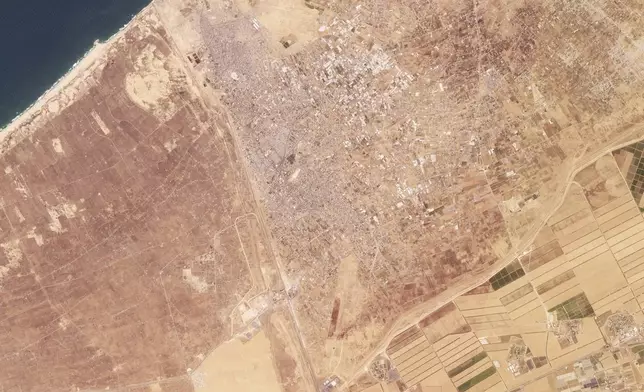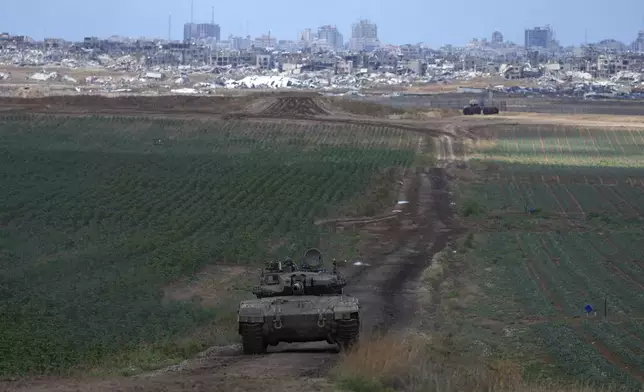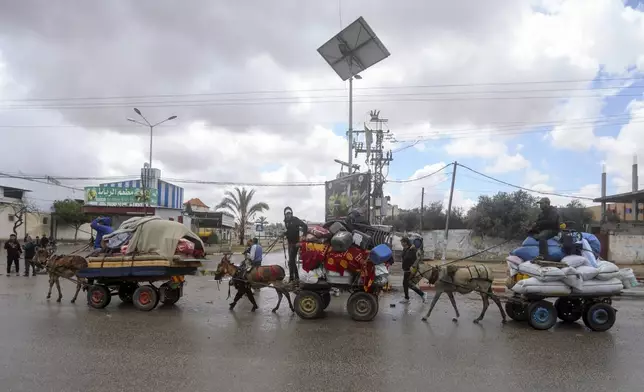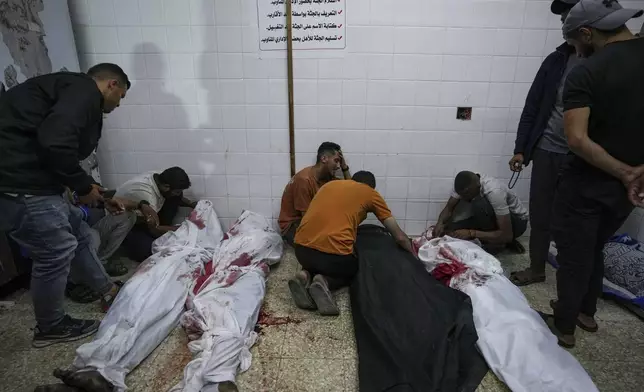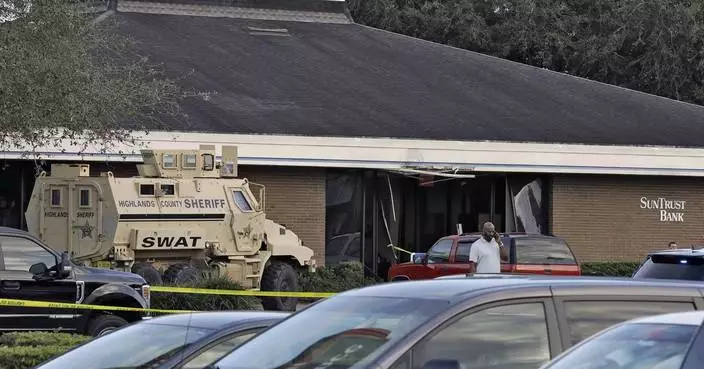JERUSALEM (AP) — Hamas announced its acceptance Monday of an Egyptian-Qatari cease-fire proposal, but Israel said the deal did not meet its “core demands” and that it was pushing ahead with an assault on the southern Gaza city of Rafah. Still, Israel said it would continue negotiations.
The high-stakes diplomatic moves and military brinkmanship left a glimmer of hope alive — but only barely — for an accord that could bring at least a pause in the 7-month-old war that has devastated the Gaza Strip. Hanging over the wrangling was the threat of an all-out Israeli assault on Rafah, a move the United States strongly opposes and that aid groups warn will be disastrous for some 1.4 million Palestinians taking refuge there.
Click to Gallery
This satellite image taken by Planet Labs PBC shows Rafah in the Gaza Strip, center, Saturday, May 4, 2024. The Israeli army ordered some 100,000 Palestinians on Monday, May 6, 2024, to begin evacuating from the southern city of Rafah in Gaza, signaling that a long-promised ground invasion there could be imminent and further complicating efforts to broker a cease-fire. In the image, Egypt can be seen to the left, Israel to the bottom right corner. (Planet Labs PBC via AP)
JERUSALEM (AP) — Hamas announced its acceptance Monday of an Egyptian-Qatari cease-fire proposal, but Israel said the deal did not meet its “core demands” and that it was pushing ahead with an assault on the southern Gaza city of Rafah. Still, Israel said it would continue negotiations.
Israeli protesters block a highway during a demonstration calling on the government to reach a cease-fire deal with Hamas to bring home hostages in Tel Aviv, Israel, May 6, 2024. The protesters took to the streets after the government appeared to spurn a deal accepted by Hamas. Israel said it would continue negotiations. (AP Photo/Ariel Schalit)
Israeli police disperse demonstrators blocking a highway during a protest calling on the government to reach a cease-fire deal with Hamas to bring home hostages in Tel Aviv, Israel, May 6, 2024. The protesters took to the streets after the government appeared to spurn a deal accepted by Hamas. Israel said it would continue negotiations. (AP Photo/Ariel Schalit)
Israeli police disperse demonstrators blocking a highway during a protest calling on the government to reach a cease-fire deal with Hamas to bring home hostages in Tel Aviv, Israel, May 6, 2024. The protesters took to the streets after the government appeared to spurn a deal accepted by Hamas. Israel said it would continue negotiations. (AP Photo/Ariel Schalit)
Smoke rises following an Israeli airstrike east of Rafah, Gaza Strip, Monday, May 6, 2024. (AP Photo/Ismael Abu Dayyah)
This satellite image taken by Planet Labs PBC shows Rafah in the Gaza Strip, center, Saturday, May 4, 2024. The Israeli army ordered some 100,000 Palestinians on Monday, May 6, 2024, to begin evacuating from the southern city of Rafah in Gaza, signaling that a long-promised ground invasion there could be imminent and further complicating efforts to broker a cease-fire. In the image, Egypt can be seen to the left, Israel to the bottom right corner. (Planet Labs PBC via AP)
An Israeli Defense Forces tank drives away from the Gaza Strip, as seen from southern Israel, Monday, May 6, 2024. (AP Photo/Tsafrir Abayov)
Mourners carry the coffins of two victims who were among four civilians from the same family that killed on Sunday by Israeli strikes on the southern town of Mays al-Jabal, during their funeral procession, in Beirut, Monday, May 6, 2024. Hezbollah militants and Israeli forces have been exchanging fire in south Lebanon since a day after the Israel-Hamas war began on Oct. 7. (AP Photo/Hussein Malla)
A Lebanese woman mourns, as she holds a frame with the portraits of two victims who were among four civilians from the same family that killed on Sunday by Israeli strikes on the southern town of Mays al-Jabal, during their funeral procession, in Beirut, Monday, May 6, 2024. Hezbollah militants and Israeli forces have been exchanging fire in south Lebanon since a day after the Israel-Hamas war began on Oct. 7. (AP Photo/Hussein Malla)
People attend a ceremony at the former Nazi German death camp of Auschwitz-Birkenau during the annual Holocaust remembrance event, the "March of the Living" in memory of the six million Holocaust victims in Oswiecim, Poland, Monday, May 6, 2024. The event comes amid the dramatic backdrop of the violence of the Israel-Hamas war after the Oct. 7 Hamas attack, the deadliest violence against Jews since the Holocaust, and as pro-Palestinian protests sweep U.S. campuses. (AP Photo/Czarek Sokolowski)
Palestinians flee from the eastern side of the southern Gaza city of Rafah after the Israeli army orders them to evacuate ahead of a military operation, in Rafah, Gaza Strip, Monday, May 6, 2024. The order affects tens of thousands of people and could signal a broader invasion of Rafah, which Israel has identified as Hamas' last major stronghold after seven months of war. (AP Photo/Ismael Abu Dayyah)
An Israeli Defense Forces tank drives away from the Gaza Strip, as seen from southern Israel, Monday, May 6, 2024. (AP Photo/Tsafrir Abayov)
Palestinians flee from the eastern side of the southern Gaza city of Rafah after the Israeli army orders them to evacuate ahead of a military operation, in Rafah, Gaza Strip, Monday, May 6, 2024. The order affects tens of thousands of people and could signal a broader invasion of Rafah, which Israel has identified as Hamas' last major stronghold after seven months of war. (AP Photo/Ismael Abu Dayyah)
Palestinians hold leaflets dropped by Israeli planes calling on them to evacuate ahead of an Israeli military operation in Rafah, southern Gaza Strip, Monday, May 6, 2024. The order affects tens of thousands of people and could signal a broader invasion of Rafah, which Israel has identified as Hamas' last major stronghold after seven months of war. (AP Photo/Ismael Abu Dayyah)
Israeli soldiers drive a tank at a staging ground near the border with the Gaza Strip, in southern Israel, Sunday, May 5, 2024. (AP Photo/Tsafrir Abayov)
Palestinians react next to the bodies of their relatives who were killed in an Israeli airstrike in Gaza Stirp, at the Al Aqsa hospital in Deir al Balah, Gaza, Sunday, May 5, 2024. (AP Photo/Abdel Kareem Hana)
Palestinians react next to the bodies of their relatives who were killed in an Israeli airstrike in Gaza Stirp, at the Al Aqsa hospital in Deir al Balah, Gaza, Sunday, May 5, 2024. (AP Photo/Abdel Kareem Hana)
A Palestinian woman mourns her relative, 7-month old baby Hani Qeshta, who was killed in an Israeli bombardment on a residential building with Qeshta's family, at the morgue of Al Najjar hospital in Rafah, southern Gaza Strip, Sunday, May 5, 2024. (AP Photo/Ismael Abu Dayyah)
The Qeshta family is seen in body bags at the morgue of Al Najjar hospital in Rafah, southern Gaza Strip, Sunday, May 5, 2024. The family was killed in an Israeli bombardment on a residential building in Rafah. (AP Photo/Ismael Abu Dayyah)
A Palestinian woman mourns her relative, 7-month old baby Hani Qeshta, who was killed in an Israeli bombardment on a residential building with Qeshta's family, at the morgue of Al Najjar hospital in Rafah, southern Gaza Strip, Sunday, May 5, 2024. (AP Photo/Ismael Abu Dayyah)
Hamas's abrupt acceptance of the cease-fire deal came hours after Israel ordered an evacuation of some 100,000 Palestinians from eastern neighborhoods of Rafah, signaling an invasion was imminent.
The Israeli military said it was conducting “targeted strikes” against Hamas in eastern Rafah. Soon after, Israeli tanks entered Rafah, reaching as close as 200 meters (yards) from Rafah’s crossing with neighboring Egypt, a Palestinian security official and an Egyptian official said. Both spoke on condition of anonymity because they were not authorized to talk to the press. The reported incursion came a day after Hamas militants killed four Israeli soldiers in a mortar attack that Israel said originated near the Rafah crossing.
The Egyptian official said the operation appeared to be limited. The Associated Press could not independently verify the scope of the operation.
Israeli airstrikes also hit elsewhere in Rafah late Monday, killing at least five people, including a child and a woman, hospital officials said.
The Israeli military declined to comment.
Shortly after Hamas said it had accepted the Egyptian-Qatari truce proposal, Israel's War Cabinet decided to continue the Rafah operation, Prime Minister Benjamin Netanyahu 's office said. It also said that while the proposal Hamas agreed to “is far from meeting Israel’s core demands,” it would send negotiators to Egypt to work on a deal. Late Monday, Qatar announced it was sending a team to Egypt as well.
President Joe Biden spoke with Netanyahu and reiterated U.S. concerns about an invasion of Rafah. U.S. State Department spokesman Matthew Miller said American officials were reviewing the Hamas response “and discussing it with our partners in the region.”
It was not immediately known if the proposal Hamas agreed to was substantially different from one that U.S. Secretary of State Antony Blinken pressed the militant group to accept last week, which Blinken said included significant Israeli concessions.
An American official said the U.S. was examining whether what Hamas agreed to was the version signed off on by Israel and international negotiators or something else.
Egyptian officials said that proposal called for a cease-fire of multiple stages starting with a limited hostage release and partial Israeli troop pullbacks within Gaza. The two sides would also negotiate a “permanent calm” that would lead to a full hostage release and greater Israeli withdrawal out of the territory, they said.
Hamas sought clearer guarantees for its key demand of an end to the war and complete Israeli withdrawal in return for the release of all hostages, but it wasn't clear if any changes were made.
Israeli leaders have repeatedly rejected that trade-off, vowing to keep up their campaign until Hamas is destroyed after its Oct. 7 attack on Israel that triggered the war.
Netanyahu is under pressure from hard-line partners in his coalition who demand an attack on Rafah and could collapse his government if he signs a deal. But he also faces pressure from the families of hostages to reach a deal for their release. They say that time is running out to bring their loved ones home safely, and a ground operation would further endanger them.
Thousands of Israelis rallied around the country Monday night calling for an immediate agreement. About 1,000 protesters swelled near the defense headquarters in Tel Aviv. In Jerusalem, about 100 protesters marched toward Netanyahu's residence with a banner reading, “The blood is on your hands.“
Israel says Rafah is the last significant Hamas stronghold in Gaza, and Netanyahu said Monday that the offensive against the city was vital to ensuring the militants can’t rebuild their military capabilities.
But he faces strong American opposition. Miller said Monday the U.S. has not seen a credible plan to protect Palestinian civilians. “We cannot support an operation in Rafah as it is currently envisioned,” he said.
The looming operation has raised global alarm. Aid agencies have warned that an offensive will bring a surge of more civilian deaths in an Israeli campaign that has already killed over 34,000 people and devastated the territory. It could also wreck the humanitarian aid operation based out of Rafah that is keeping Palestinians across the Gaza Strip alive, they say.
Israeli leaflets, text messages and radio broadcasts ordered Palestinians to evacuate eastern neighborhoods of Rafah, warning that an attack was imminent and anyone who stays “puts themselves and their family members in danger.”
The military told people to move to an Israel-declared humanitarian zone called Muwasi, a makeshift camp on the coast. It said Israel has expanded the size of the zone and that it included tents, food, water and field hospitals.
It wasn’t immediately clear, however, if that was already in place.
Around 450,000 displaced Palestinians already are sheltering in Muwasi. The U.N. agency for Palestinian refugees, known as UNRWA, said it has been providing them with aid. But conditions are squalid, with few sanitation facilities in the largely rural area, forcing families to dig private latrines.
The evacuation order left Palestinians in Rafah wrestling with having to uproot their families once again for an unknown fate, exhausted after months living in sprawling tent camps or crammed into schools or other shelters in and around the city. Israeli airstrikes on Rafah early Monday killed 22 people, including children and two infants.
Mohammed Jindiyah said that at the beginning of the war, he tried to hold out in his home in northern Gaza under heavy bombardment before fleeing to Rafah.
He is complying with Israel's evacuation order this time, but was unsure whether to move to Muwasi or elsewhere.
“We are 12 families, and we don’t know where to go. There is no safe area in Gaza,” he said.
Sahar Abu Nahel, who fled to Rafah with 20 family members, including her children and grandchildren, wiped tears from her cheeks, despairing at a new move.
“I have no money or anything. I am seriously tired, as are the children,” she said. “Maybe it’s more honorable for us to die. We are being humiliated.”
The war was sparked by the unprecedented Oct. 7 raid into southern Israel in which Palestinian militants killed around 1,200 people, mostly civilians, and abducted some 250 hostages. After exchanges during a November cease-fire, Hamas is believed to still hold about 100 Israelis as well the bodies of around 30 others.
Mroue reported from Beirut. Samy Magdy and Lee Keath in Cairo and Zeke Miller in Washington contributed.

Palestinians celebrate in the streets following Hamas's announcement that it accepted a cease-fire proposal in Deir al-Balah, Gaza Strip on Monday, May 6, 2024. Despite the Hamas announcement, Israel said later Monday it would move forward with its planned offensive on Rafah, in the south of the strip. (AP Photo/Abdel Kareem Hana)

Israeli protesters block a highway during a demonstration calling on the government to reach a cease-fire deal with Hamas to bring home hostages in Tel Aviv, Israel, May 6, 2024. The protesters took to the streets after the government appeared to spurn a deal accepted by Hamas. Israel said it would continue negotiations. (AP Photo/Ariel Schalit)

Israeli police disperse demonstrators blocking a highway during a protest calling on the government to reach a cease-fire deal with Hamas to bring home hostages in Tel Aviv, Israel, May 6, 2024. The protesters took to the streets after the government appeared to spurn a deal accepted by Hamas. Israel said it would continue negotiations. (AP Photo/Ariel Schalit)

Israeli police disperse demonstrators blocking a highway during a protest calling on the government to reach a cease-fire deal with Hamas to bring home hostages in Tel Aviv, Israel, May 6, 2024. The protesters took to the streets after the government appeared to spurn a deal accepted by Hamas. Israel said it would continue negotiations. (AP Photo/Ariel Schalit)

Smoke rises following an Israeli airstrike east of Rafah, Gaza Strip, Monday, May 6, 2024. (AP Photo/Ismael Abu Dayyah)

This satellite image taken by Planet Labs PBC shows Rafah in the Gaza Strip, center, Saturday, May 4, 2024. The Israeli army ordered some 100,000 Palestinians on Monday, May 6, 2024, to begin evacuating from the southern city of Rafah in Gaza, signaling that a long-promised ground invasion there could be imminent and further complicating efforts to broker a cease-fire. In the image, Egypt can be seen to the left, Israel to the bottom right corner. (Planet Labs PBC via AP)
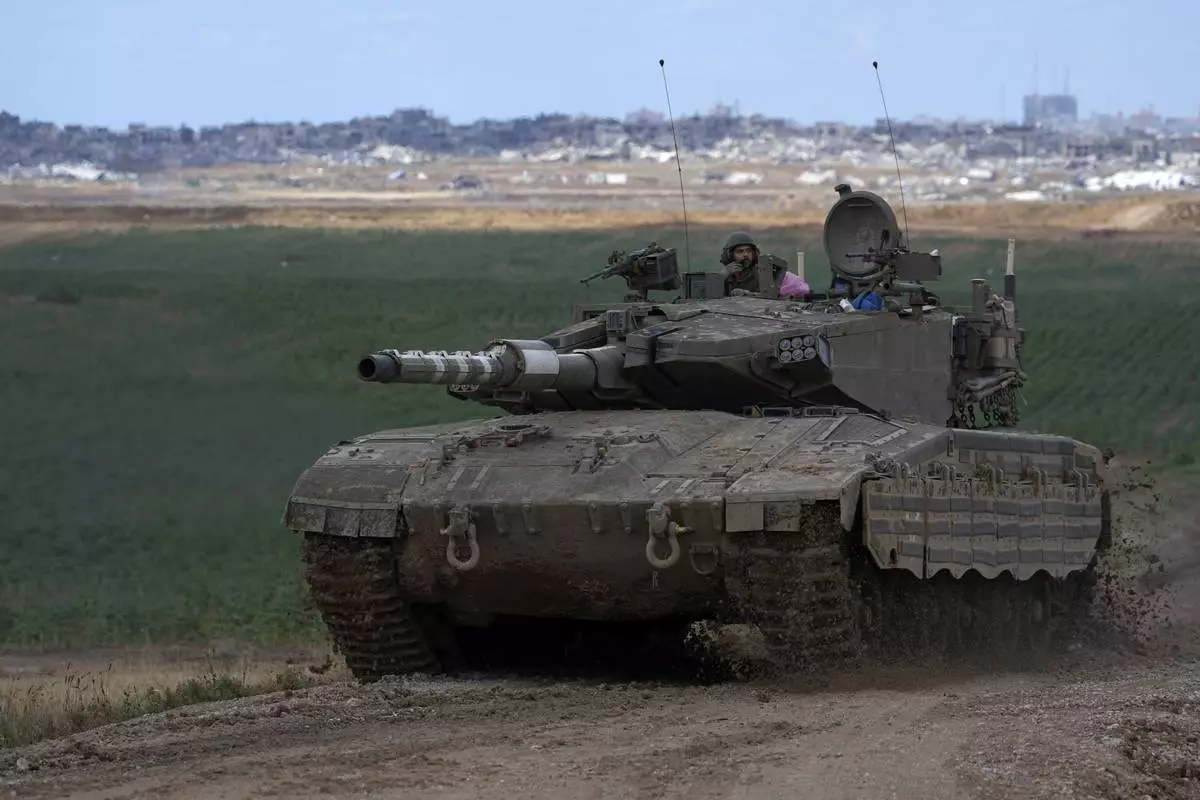
An Israeli Defense Forces tank drives away from the Gaza Strip, as seen from southern Israel, Monday, May 6, 2024. (AP Photo/Tsafrir Abayov)
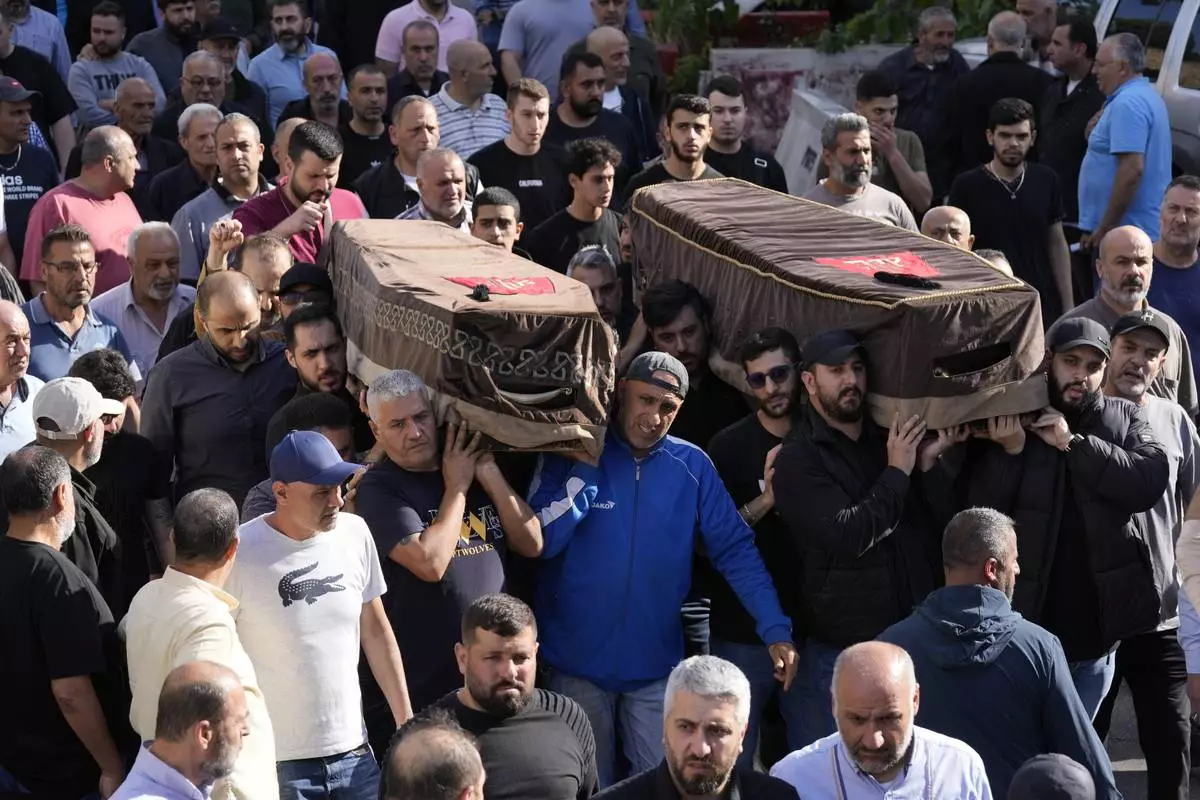
Mourners carry the coffins of two victims who were among four civilians from the same family that killed on Sunday by Israeli strikes on the southern town of Mays al-Jabal, during their funeral procession, in Beirut, Monday, May 6, 2024. Hezbollah militants and Israeli forces have been exchanging fire in south Lebanon since a day after the Israel-Hamas war began on Oct. 7. (AP Photo/Hussein Malla)
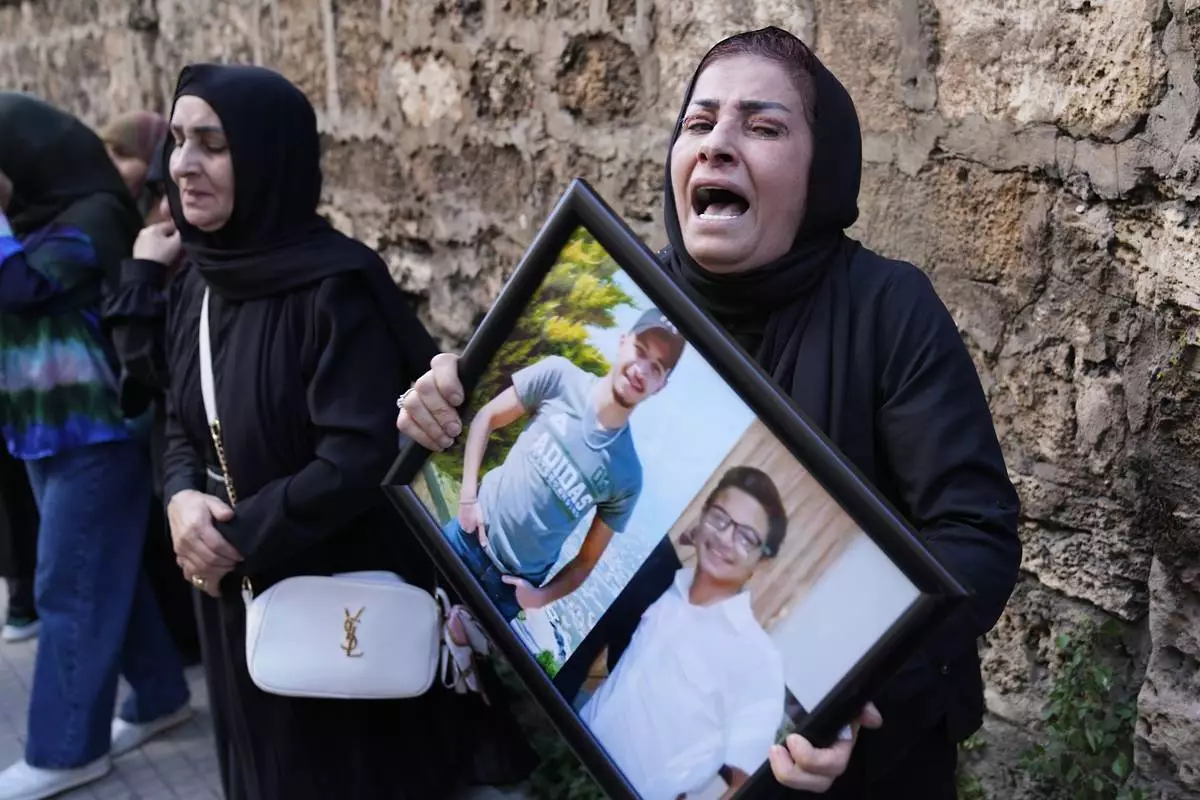
A Lebanese woman mourns, as she holds a frame with the portraits of two victims who were among four civilians from the same family that killed on Sunday by Israeli strikes on the southern town of Mays al-Jabal, during their funeral procession, in Beirut, Monday, May 6, 2024. Hezbollah militants and Israeli forces have been exchanging fire in south Lebanon since a day after the Israel-Hamas war began on Oct. 7. (AP Photo/Hussein Malla)

People attend a ceremony at the former Nazi German death camp of Auschwitz-Birkenau during the annual Holocaust remembrance event, the "March of the Living" in memory of the six million Holocaust victims in Oswiecim, Poland, Monday, May 6, 2024. The event comes amid the dramatic backdrop of the violence of the Israel-Hamas war after the Oct. 7 Hamas attack, the deadliest violence against Jews since the Holocaust, and as pro-Palestinian protests sweep U.S. campuses. (AP Photo/Czarek Sokolowski)
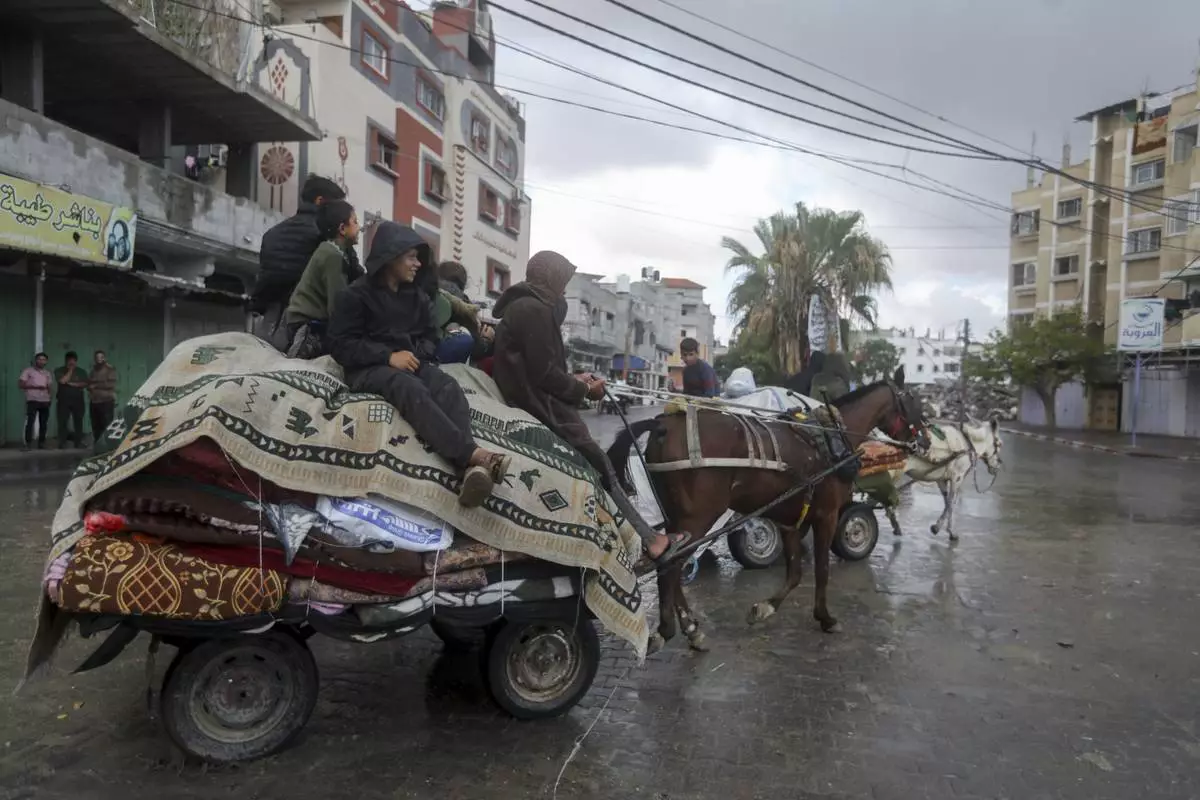
Palestinians flee from the eastern side of the southern Gaza city of Rafah after the Israeli army orders them to evacuate ahead of a military operation, in Rafah, Gaza Strip, Monday, May 6, 2024. The order affects tens of thousands of people and could signal a broader invasion of Rafah, which Israel has identified as Hamas' last major stronghold after seven months of war. (AP Photo/Ismael Abu Dayyah)

An Israeli Defense Forces tank drives away from the Gaza Strip, as seen from southern Israel, Monday, May 6, 2024. (AP Photo/Tsafrir Abayov)

Palestinians flee from the eastern side of the southern Gaza city of Rafah after the Israeli army orders them to evacuate ahead of a military operation, in Rafah, Gaza Strip, Monday, May 6, 2024. The order affects tens of thousands of people and could signal a broader invasion of Rafah, which Israel has identified as Hamas' last major stronghold after seven months of war. (AP Photo/Ismael Abu Dayyah)
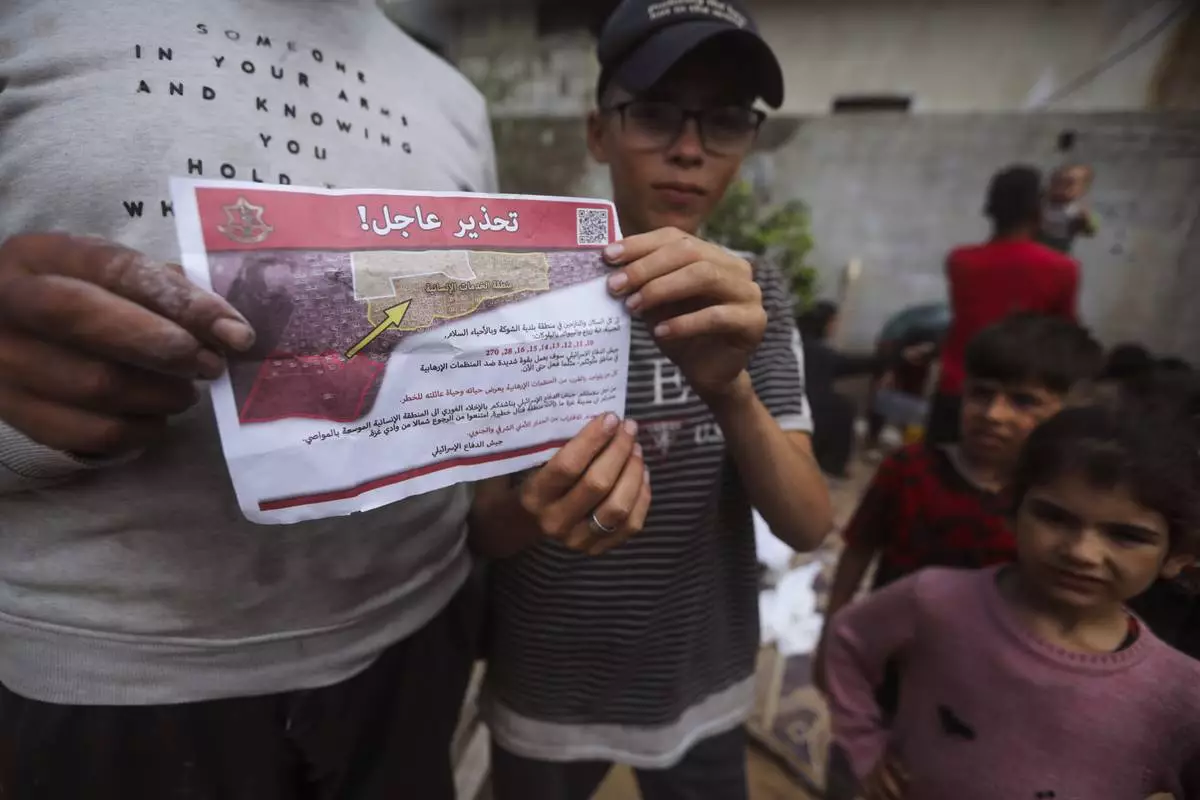
Palestinians hold leaflets dropped by Israeli planes calling on them to evacuate ahead of an Israeli military operation in Rafah, southern Gaza Strip, Monday, May 6, 2024. The order affects tens of thousands of people and could signal a broader invasion of Rafah, which Israel has identified as Hamas' last major stronghold after seven months of war. (AP Photo/Ismael Abu Dayyah)

Israeli soldiers drive a tank at a staging ground near the border with the Gaza Strip, in southern Israel, Sunday, May 5, 2024. (AP Photo/Tsafrir Abayov)

Palestinians react next to the bodies of their relatives who were killed in an Israeli airstrike in Gaza Stirp, at the Al Aqsa hospital in Deir al Balah, Gaza, Sunday, May 5, 2024. (AP Photo/Abdel Kareem Hana)
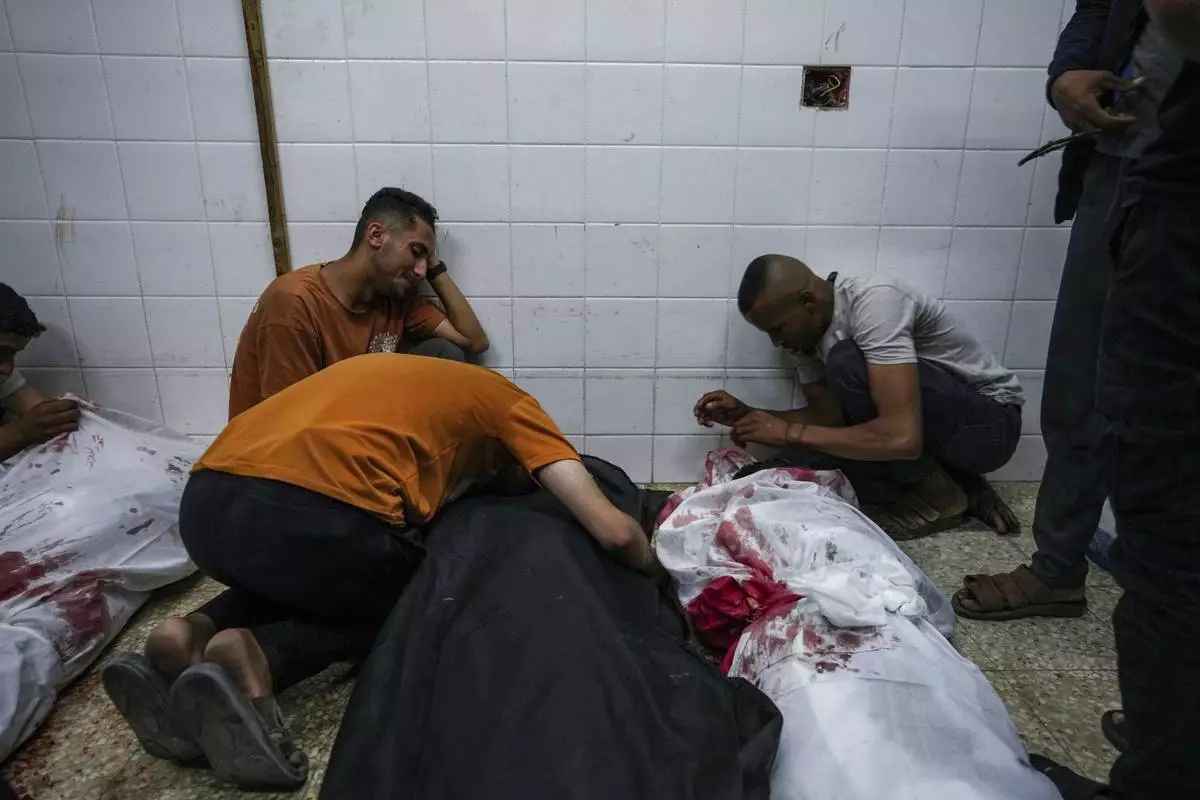
Palestinians react next to the bodies of their relatives who were killed in an Israeli airstrike in Gaza Stirp, at the Al Aqsa hospital in Deir al Balah, Gaza, Sunday, May 5, 2024. (AP Photo/Abdel Kareem Hana)

A Palestinian woman mourns her relative, 7-month old baby Hani Qeshta, who was killed in an Israeli bombardment on a residential building with Qeshta's family, at the morgue of Al Najjar hospital in Rafah, southern Gaza Strip, Sunday, May 5, 2024. (AP Photo/Ismael Abu Dayyah)
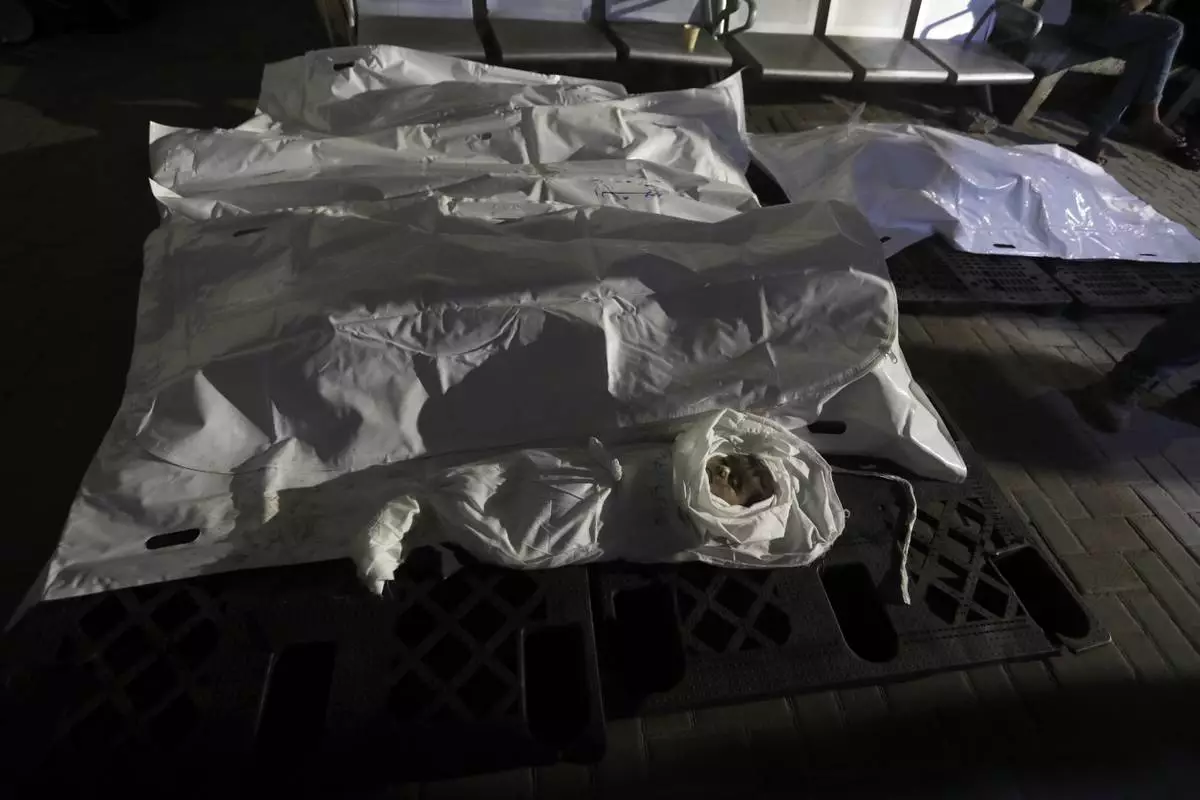
The Qeshta family is seen in body bags at the morgue of Al Najjar hospital in Rafah, southern Gaza Strip, Sunday, May 5, 2024. The family was killed in an Israeli bombardment on a residential building in Rafah. (AP Photo/Ismael Abu Dayyah)
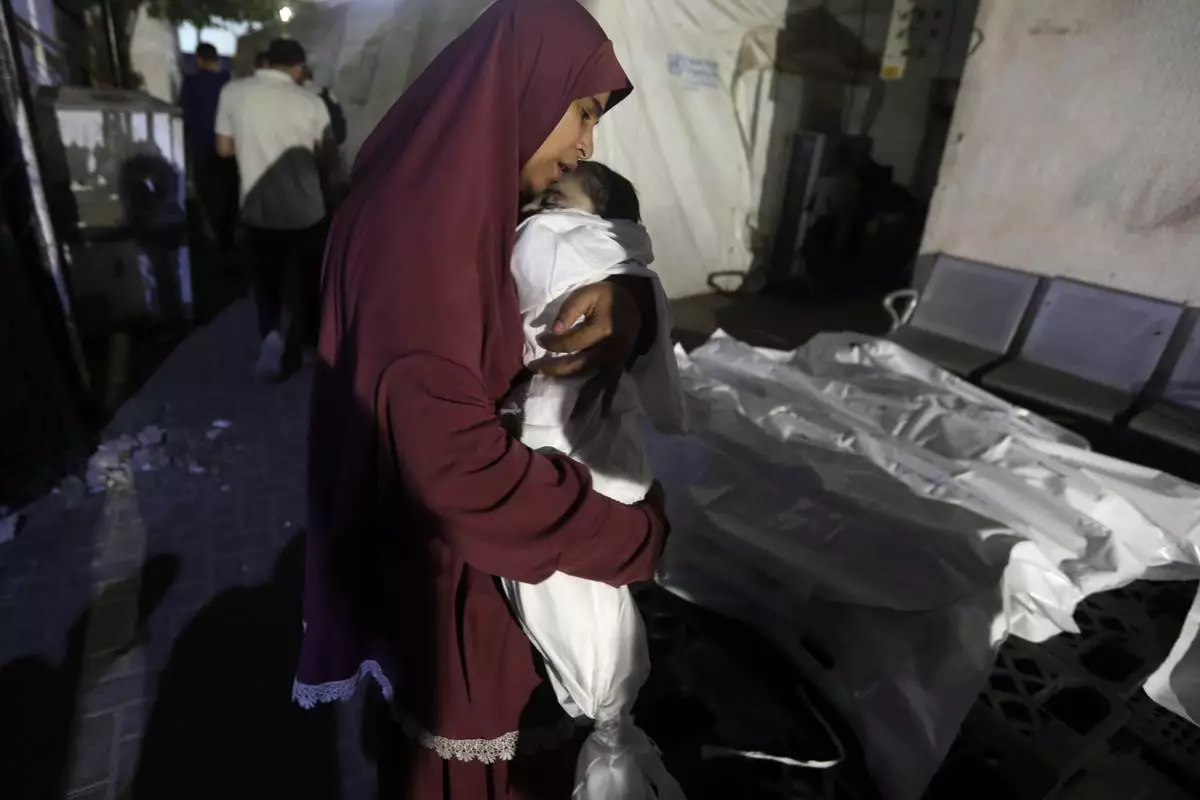
A Palestinian woman mourns her relative, 7-month old baby Hani Qeshta, who was killed in an Israeli bombardment on a residential building with Qeshta's family, at the morgue of Al Najjar hospital in Rafah, southern Gaza Strip, Sunday, May 5, 2024. (AP Photo/Ismael Abu Dayyah)
JACUMÉ, México (AP) — Near the towering border wall flanked by a U.S. Border Patrol vehicle, botanist Sula Vanderplank heard a quail in the scrub yelp “chi-ca-go,” a sound the birds use to signal they are separated from a mate or group.
Then silence.
A quail on the Mexican side called back, triggering a back-and-forth soundtrack that was both fitting and heartbreaking in an ecosystem split by an artificial barrier.
Vanderplank was among several botanists and citizen scientists participating in the Border Bioblitz near the Mexican community of Jacumé, about 60 miles (100 kilometers) east of Tijuana.
Roughly 1,000 volunteers armed with the iNaturalist app on their smartphones are documenting as many species as possible along the U.S.-Mexico border in May. Uploading photos to the app helps identify plants and animals, and records the coordinates of the location.
The hope is the information could lead to more protections for the region's natural richness, which is overshadowed by news of drug trafficking and migrant smuggling.
On a recent day, Bioblitz volunteers scrutinized a bright yellow blooming carpet of common Goldfields, a sharp contrast to the imposing steel bollards of the border wall topped with rolls of razor wire. Some navigated their way around piles of empty water jugs, a gray hoodie and empty cans of tuna fish left under the branches of native flora like the Tecate Cypress.
“There’s a fabulous amount of biodiversity here that’s traditionally been overlooked,” Vanderplank, of the binational program Baja Rare, said.
The efforts started in response to former President Donald Trump adding hundreds of miles of border walls that toppled untold numbers of saguaro cactuses in Arizona and passed through the biodiversity hotspot of Baja California.
“When the border wall construction began, we realized how little hard data we had, especially when it came to plants and small organisms,” Vanderplank said. “We don’t know what all we could lose.”
Since then, there has been a groundswell of initiatives to document the borderland’s flora and fauna as climate change coupled with habitat loss, pollution and development have hammered the world’s biodiversity. One estimate in 2019 warns that a million plant and animal species face extinction within decades, a rate of loss 1,000 times greater than expected.
The United Nations is expected hold a high-level meeting in Colombia of signatories to the Convention on Biological Diversity in October aiming to protect 30% of land, freshwater and oceans considered important for biodiversity by 2030, known as 30 by 30. Representatives from nearly 200 countries are expected to present plans on how they will meet conservation targets agreed upon in 2022.
Currently, 17% of terrestrial and 10% of marine areas are protected.
Baja California peninsula, which borders California and is home to Tijuana with one of Mexico's highest homicide rates, has more than 4,000 species of plants. A quarter of them are endemic and at least 400 plants are considered rare with little to no protection.
Flora and fauna that have gone extinct or are in danger of disappearing in the U.S., like the California red-legged frog, are thriving south of the border, producing specimens that are being used to bring back populations.
But the region’s crime deters many U.S. scientists from crossing the border. Mexico also is restricting permits for botanists and not allowing seeds to be collected, further curtailing the work, scientists say.
Bioblitz organizers work with local communities and say they take people only to areas deemed safe.
“You have to be really careful because of the violence,” said Jon Rebman, a curator of botany at the San Diego Natural History Museum, who has named 33 new plants for science from the southern California and Baja California region.
“It’s scary from that standpoint, yet those are the areas where we really need more information because there’s hardly any protected area on the south side,” he said.
Using the museum’s collection, Rebman made a list of 15 plant species endemic to Baja California and not seen since being collected nearly a century ago. He created a binational team to find them. So far, they have located 11.
Rebman also discovered two new plants to science in 2021 in a canyon off a Tijuana highway: the new species, Astragalus tijuanensis, and a new variety of the Astragalus brauntonii named lativexillum.
“I was worried they would go extinct before we even got them named,” Rebman said. “That tells you what type of area we’re working in.”
Tijuana-based botanist Mariana Fernandez of Expediciones Botánicas periodically checks on the plants. Working with Rebman, she is pushing Baja California to adopt more protections for its native plants. Currently only a fraction are on Mexico’s federal protection list.
She hopes the state will step in, while she also tries to build support by taking Tijuana residents and Baja officials on hikes.
“People are amazed that these things exist in Tijuana, and I hope to show more and more people so they can see the beauty, because we need that,” Fernandez said. “It’s important to not be impeded by the barriers that humans create.”
As border security increases with the number of people being displaced by natural disasters, violence and wars at record levels worldwide, more migrants are traipsing out to areas like the stretch near Jacumé. The tiny community of about 100 families includes members of the Kumeyaay tribe and sits across the border from an equally sparsely populated desert near the California town of Jacumba Hot Springs. Population: about 1,000.
The area has seen thousands of asylum seekers who wait for an opportunity to cross, usually in the cloak of darkness, and then camp again on the U.S. side after turning themselves in to U.S. Border Patrol agents.
Fernandez was among the botanists helping Bioblitz volunteers on the Mexican side near a crumbling crossing station from the 1920s.
“I never would have thought that there would be so much biodiversity on the border,” said Jocelyn Reyes, a student of Fernandez at La Universidad Autónoma de Baja California who stopped every few feet to hover over a plant and photograph its details. “It’s so interesting and makes you realize there’s so much worth saving.”

A California Horned Lizard is temporary held for classification during a botanical expedition with Universidad Autonoma de Baja California college students documenting native plants and species along the U.S.-Mexico border on Friday, April 19, 2024, in the Ejido Jacume in the Tecate Municipality of Baja California, Mexico. Botanists and citizen scientists armed with the iNaturalist app on their smartphones are recording the biodiversity along the U.S.-Mexico border in May. Called the Border Bioblitz, more than 1,000 volunteers are recording as many species as possible. (AP Photo/Damian Dovarganes)

Horses walk close to the US Mexico border Friday, April 19, 2024, in the Ejido Jacume in the Tecate Municipality of Baja California, Mexico. Botanists and citizen scientists armed with the iNaturalist app on their smartphones are recording the biodiversity along the U.S.-Mexico border in May. Called the Border Bioblitz, more than 1,000 volunteers are recording as many species as possible. (AP Photo/Damian Dovarganes)

Dr. Georges Seingier, Prof. Marine and Environmental Sciences at Baja California Autonomous University joins a botanical expedition with Universidad Autonoma de Baja California college students to document native plants along the U.S.- Mexico border on Friday, April 19, 2024, in the Ejido Jacume in the Tecate Municipality of Baja California, Mexico. The group near the Mexican community of Jacume, about (60 miles) 100 kilometers east of Tijuana, is one of several participating in the Border Bioblitz in which more than 1,000 volunteers throughout May record as many species as possible along the U.S.-Mexico border, a region plagued by drug trafficking and migrant smuggling that have overshadowed its natural richness. (AP Photo/Damian Dovarganes)

College students, members of Baja California's conservation organization Baja Rare, lead a botanical expedition to document native plants along the U.S.-Mexico border on Friday, April 19, 2024, in the Ejido Jacume in the Tecate municipality of Baja Calif., Mexico. The Baja California peninsula, which borders California and is home to Tijuana, one of the deadliest cities in the world, has more than 4,000 species of plants. According to scientists, a quarter of them are not found anywhere else, and some 200 plants are considered rare with little to no protection. (AP Photo/Damian Dovarganes)

A college student joins members of the California's Baja Rare conservation project leading a botanical expedition to document native plants along the U.S.- Mexico border on Friday, April 19, 2024, in the Ejido Jacume in the Tecate Municipality of Baja Calif., Mexico. Since then there has been a groundswell of initiatives to document the borderland's flora and fauna as climate change coupled with habitat loss, pollution and development have hammered the world's biodiversity, with one estimate in 2019 warning that a million plant and animal species face extinction within decades, a rate of loss 1,000 times greater than expected. (AP Photo/Damian Dovarganes)

Dr. Georges Seingier, Prof. Marine and Environmental Sciences at Baja California Autonomous University leads a botanical expedition with Universidad Autonoma de Baja California botanists and citizen scientists to document native plants along the U.S.- Mexico border on Friday, April 19, 2024, in the Ejido Jacume in the Tecate Municipality of Baja California, Mexico. Since then there has been a groundswell of initiatives to document the borderland's flora and fauna as climate change coupled with habitat loss, pollution and development have hammered the world's biodiversity, with one estimate in 2019 warning that a million plant and animal species face extinction within decades, a rate of loss 1,000 times greater than expected. (AP Photo/Damian Dovarganes)

Members of the Baja California's conservation Baja Rare project lead a botanical expedition with college students to document native plants along the U.S.-Mexico border on Friday, April 19, 2024, in the Ejido Jacume in the Tecate Municipality of Baja Calif., Mexico. The group near the Mexican community of Jacume, about (60 miles) 100 kilometers east of Tijuana, is one of several participating in the Border Bioblitz in which more than 1,000 volunteers throughout May record as many species as possible along the U.S.-Mexico border, a region plagued by drug trafficking and migrant smuggling that has overshadowed its natural richness. (AP Photo/Damian Dovarganes)

Lichen grows on native tree branches along the US-Mexico border on Friday, April 19, 2024, in the Ejido Jacume in the Tecate Municipality of Baja California, Mexico. Botanists and citizen scientists armed with the mobile cellphone iNaturalist app are recording the biodiversity along the U.S.-Mexico border in May. The Border Bioblitz has more than 1,000 volunteers recording as many species as possible. Flora and fauna that have gone extinct or are in danger of disappearing in the U.S. have been found to be thriving in remote spots south of the border, producing specimens that can then be used to bring back populations, scientists say. But the region's crime has deterred many U.S. scientists from crossing the border. (AP Photo/Damian Dovarganes)

Botanists and citizen scientists armed with the iNaturalist app on their smartphones record the biodiversity along the U.S.-Mexico border as bright yellow blooms carpet the ground, a sharp contrast to the imposing steel bollards of the border wall topped with rolls of razor wire as members of the California's Baja Rare project lead a botanical expedition with college students to document native plants along the US Mexico border on Friday, April 19, 2024, in the Ejido Jacume in the Tecate Municipality of Baja Calif., Mexico. (AP Photo/Damian Dovarganes)

Tijuana-based field botanist Mariana Fernandez of Expediciones Botanicas leads a botanical expedition with college students to document native plants along the U.S.- Mexico border on Friday, April 19, 2024, in the Ejido Jacume in the Tecate Municipality of Baja California, Mexico. Flora and fauna that have gone extinct or are in danger of disappearing in the U.S. have been found to be thriving in remote spots south of the border, producing specimens that can then be used to bring back populations, scientists say. But the region's crime has deterred many U.S. scientists from crossing the border. (AP Photo/Damian Dovarganes)

Botanists and citizen scientists armed with the iNaturalist app on their smartphones record the biodiversity along the U.S.-Mexico border as bright yellow blooms carpet the ground, a sharp contrast to the imposing steel bollards of the border wall topped with rolls of razor wire along the US Mexico border on Friday, April 19, 2024, near Botanists and citizen scientists armed with the iNaturalist app on their smartphones record the biodiversity along the U.S.-Mexico border as bright yellow blooms carpet the ground, a sharp contrast to the imposing steel bollards of the border wall topped with rolls of razor wire as members of the California's Baja Rare project lead a botanical expedition with college students to document native plants along the US Mexico border on Friday, April 19, 2024, near the Ejido Jacume in the Tecate Municipality of Baja Calif., Mexico. (AP Photo/Damian Dovarganes)

Bright yellow blooms carpet the ground, a sharp contrast to the imposing steel bollards of the border wall topped with rolls of razor wire as members of the California's Baja Rare conservation project lead a botanical expedition with botanists and citizen scientists to document native plants along the U.S.- Mexico border on Friday, April 19, 2024, in the Ejido Jacume in the Tecate Municipality of Baja Calif., Mexico. (AP Photo/Damian Dovarganes)






















